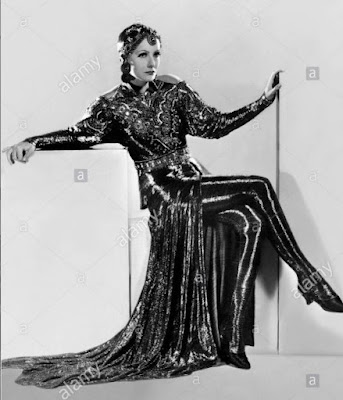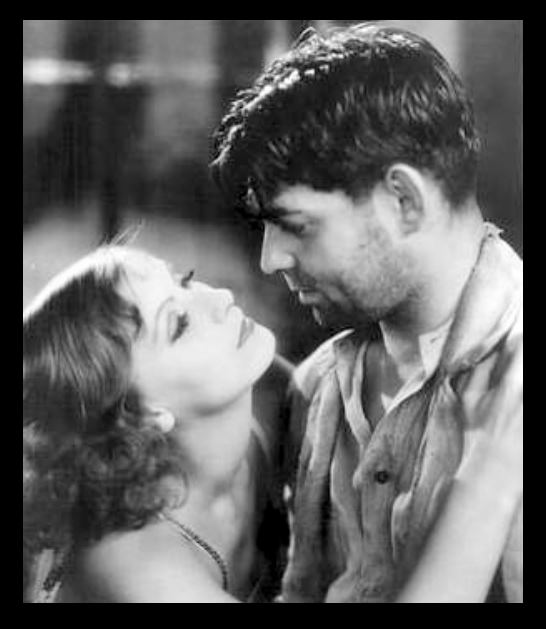Greta Garbo's Movies Get the TV Guide Treaztment : "Romance" to Mata Hari"
"Romance"
Garbo's Swedish accent is not usually an issue for me, and who am I to criticize? Garbo could speak Swedish, English, and German at least and maybe other languages as well. I speak English and know fifty words in French and fewer words than that in Spanish. Since "Romance" is Garbo's second talking picture after "Anna Christie," every time I watch I expect that her English will be better. But these are two different movies. Maybe the direction Garbo got in "Anna Christie" made it easier to understand her, because Anna's character is plain-spoken and everybody talks loudly in that movie. It's different in "Romance," in which the lovers are murmuring a lot. Or were there better soundstages in "Anna Christie"? I don't know. I do know that when i try to understand what Greta Garbo's character says in "Romance," all I seem to hear in my head is the puppet chef from "Sesame Street."
In keeping with this TV Guide -themed series, I'm doing short summaries of each film's complicated plot. Here, very briefly, is what happens in "Romance"
On New Year's Eve, a young man, Harry, tells his bishop grandpa that he wants to marry an actress, and Grandpa remembers his own youthful fling, not with an actress but rather an Italian opera singer named Rita Cavellini. The opera star, it turns out, is also the mistress of an industrialist played by Lewis Stone. Stone's character's first name is Cornelius; go figure. So Grandpa married Grandma instead. Then he tells his grandson not to be a chickensh*t and to marry the woman he really loves no matter what others think.
"Inspiration"
This one was made well into the sound-film era, but it's definitely a movie to be looked at rather than one in which to listen for sparkling dialogue. "Inspiration" was designed to look artistic in every shot; Garbo's character loves the bohemian / salon life, and there's no place she'd rather be than an art gallery, where she fits right in like a gracefully-posed living sculpture.
In fact, Garbo poses so often in "Inspiration" that Madonna's music video "Vogue" kept coming to mind as I watched the movie.
The storyline of "Inspiration":
Artist's model Yvonne falls in love with a younger man, Andre, who's building a career as a diplomat. Andre finds out that Yvonne had boyfriends before and freaks out. leaving her. When he encounters her again, living in poverty, he offers to let her live in a little cottage he owns, just outside Paris, and they become friends without the romance. Andre is engaged to someone else, and Yvonne says she's worried she'll get kicked to the curb again. Conveniently, Andre realizes he loves Yvonne and he'll be with her, even though this will ruin his chances of being a distinguished diplomat someday. Yvonne, who has a heart of gold of course, sneaks out one night while Andre is sleeping to go be with one of her old boyfriends so her sweetheart can go on to be a success in life.
"Susan Lenox, Her Fall and Rise"
Let's make short work of "Susan Lenox," shall we? This might be my least-favorite Garbo film, in part because she and leading man Clark Gable have the opposite of onscreen chemistry, as is evident in these publicity stills.
IMDb's very short plot summary will do nicely, I think:
Susan, an orphan, lives the life of Cinderella with rustic relatives. She escapes one stormy night when the fiance her relatives chose tries to force his attentions. Rodney, an architecht, is the prince who rescues her, but he has to take a trip and the wicked relatives catch up with her again. Her next rescuer is a tatooed lady in a circus who can't save her from the circus manager. Rodney shows up and dismisses her as a fallen woman. Susan moves up in the world to the penthouse of a politician who can offer a construction contract to Rodney. Rodney says no and flees to the jungle with Susan in pursuit.
And now we've finally gotten to. . .
"Mata Hari"
The real Mata Hari and the Greta Garbo version:
The movie "Mata Hari" is a biopic that doesn't follow the facts any too closely. Mata Hari's birth name was Margaretha Geertruida Zelle. She had a tumultuous childhood: her father's small business failed, her career as a teacher ended with Zelle being chased by headmaster of school, and her only option was to became the mail-order bride of a Colonial Army officer in Indonesia. Her new husband turned out to be an alcoholic and wife-beater who also kept a local woman as a concubine. Zelle, used to coping any way she could, left him to move in with another officer, and then spent her time immersing herself in Indosian/Malay culture. She learned to dance and taking the name Mata Hari, which translates to "eye of the day." She turned to her husband, with whom she had children, and from whom she contracted syphilis. The children contracted the illness, and one child died.
The grieving mother got cutosdy of the remaining child or children after divorce, but her husband kept their daughter after a visit, and Mata Hari had no way to get the girl back. The nature of her work didn't help; she'd shifted from native dancer to exotic dancer. Mata Hari then oved to Paris, became a horse rider in a circus, then an artist's model then an erotic dancer again. Predictably she became the long-time mistress of a millionaire, Lyon industrialist Émile Étienne Guimet, who had founded the Musée.
Mata Hari didn't want to be herself any more, and she turned to the traditional practice used by white people of European descent: cultural appropriattion. Mata Hari's publicity machine sazid she was a Javanese princess of priestly Hindu birth, immersed in the art of sacred Indian dance. Mata Hari was whisked around the world by high-ranking military officials in countries which were fighting the First World War. The Germans used Mata Hari against the French, then French used her against the Germans, adding the step of executing her as a spy.
The Hollywood version, as the plot of "Mata Hari":
The pilot's goal is to bed Mata Hari and then leave her in the lurch, and he achieves his target. Apparently it never occurs to him that maybe she did the deed because she's a spy and wants to know what was in those Russian military dispatches.
The head of France's spy network, Dubois -- remember him? -- is worried about the military secrets and he tells his superior that he thinks Mata Hari has been stealing secrets. His boss laughs, and we find out this is because Mata Hari doesn't have to take information; he (the boss) has already been giving his exotic mistress all kinds of secrets.
Dubois figures out that his boss knows Mata Hari, because he comes back after the meeting to find out if there is any other important military intelligence stuff he's supposed to do, and finds a romantic dinner date happening. Mata Hari shifts her attention to the pilot, and while she's batting her eyelashes and all that, her secret spy buddy has stolen the dispatches, taken spy-camera photos, and put the papers back again.
Spy supervisor Dubois tells his boss that he is a big dumb-bell who is letting Mata Hari steal secrets. The boss thinks Dubois or the Russian pilot or both are going to take his girlfriend, and he says he will call Important People and rat them out. Mata Hari loves the Russian pilot so she shoots the spy boss before he can make the call, then she goes into hiding.
She emerges from her hideout on the news that Rasanoff's plane crashed as he flew back to Russia, and that the pilot is injured. Mata Hari goes to see her temporarily-blinded lover, and is arrested by Dubois. Mata Hari is put on trial and would probably have been freed because of weak evidence but when there's a threat to have Rasanoff testify about seeing her after the shooting, Mata Hari admits she's guilty and is sentenced to death. Rasanoff is out of the loop, as he's still recovering from his injuries and there was no cable TV or internet then, so he buys it when he gets a letter from Mata Hari saying she can't come visit as she's going to a sanatorium for a health treatment.
Rasanoff comes to see Mata Hari at the "sanatorium," which is actually the prison where the execution will happen. There are nuns there to help save Mata Hari's soul and they pretend to be nurses. The nurses take Mata Hari away for her "operation," and the pilot says they're going to have good times when she's all well again. The movie audience sobs, and the house lights come up.
Next week: "Grand Hotel"











Comments
Post a Comment